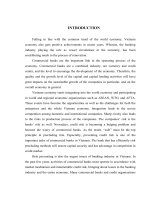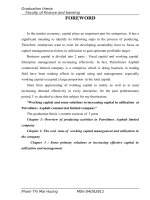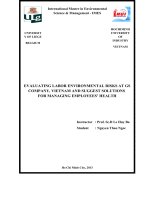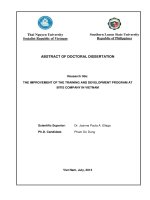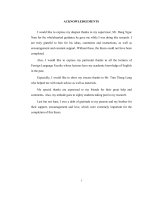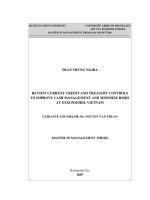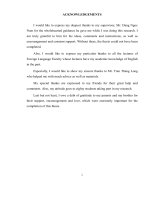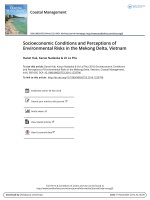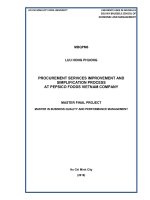EVALUATING LABOR ENVIRONMENTAL RISKS AT GS COMPANY, VIETNAM AND SUGGEST SOLUTIONS
Bạn đang xem bản rút gọn của tài liệu. Xem và tải ngay bản đầy đủ của tài liệu tại đây (1.37 MB, 60 trang )
INSTRUCTOR’S COMMENTS
Hochiminh city , Jan 25
th
, 2013
INSTRUCTOR’S SIGNATURE
International Master in Environmental
Science & Management - IMES
UNIVERSIT
Y OF LIEGE
BELGIUM
HOCHIMINH
UNIVERSITY
OF
INDUSTRY
VIETNAM
EVALUATING LABOR ENVIRONMENTAL RISKS AT GS
COMPANY, VIETNAM AND SUGGEST SOLUTIONS
FOR MANAGING EMPLOYEES’ HEALTH
Instructor : Prof. Sc.D Le Huy Ba
Student : Nguyen Thao Ngoc
Ho Chi Minh City, 2013
University of Liege in Belgium SOCIALIST REPUBLIC OF VIETNAM
HoChiMinh City University of Industry Independence - Freedom - Happiness
THESIS MISSION
Full name: Nguyen Thao Ngoc Sex : Female
Date of birth: April 6
th
, 1981 Place of birth : Binh Duong
Major: Specialized Science & Environmental Management
Course: 2/ 2012
I. Thesis name: EVALUATING LABOR ENVIRONMENTAL RISKS AT GS COMPANY,
VIETNAM AND SUGGEST SOLUTIONS FOR MANAGING EMPLOYEES’
HEALTH.
II. MISSION AND CONTENT:
Carry out the assessment of labor environmental risks and propose solutions for
laborers’ health.
III. INSTRUCTOR: Prof. Sc.D Le Huy Ba
Hochiminh City, …………… , 2013
TRAINING DEPARTMENT SPECIALIZED BRANCH
DEAN OF SPECIALIZED
BRANCH
Acknowledment
I would like to express many thanks to Prof. Sc.D Le Huy Ba for his dedicated
guidance and valuable comments during my research process and completing the thesis.
I would like to send my thanks to all Lecturers and Professors from UIH and Liege
University in charge of this course taught with whole-hearted attitudes as well as
transferred knowledge and experience enthusiastically in the past school year.
I also thank you all administrators and relevant departments of UIH as well as
Environmental Institutes created the best conditions for me to complete this course.
I especially send my best thanks to Vietnam GS Company gave me a chance to
measure and interview the employees in order to have data for the research.
I would like to thank all Professors due to valuable comments and criticisms for my
thesis.
Finally, I would like to express my deep gratitude to Board of Managers of
Binhduong Centre of Labor Health and Environment, Doctor Ho Hoang Van, Doctor
Nguyen Van Tho, and all staff of testing department in my process of measuring and
examing, all my colleagues at the Centre, as well as my dear friends in my class.
BinhDuong, May 2013
Nguyen Thao Ngoc
SUMMARY OF THE THESIS
This thesis carried out to assess the risks of environment and laborers’ health in the
environment where is contaminated by lead and to evaluate the rate of lead exposure on
laborers for a long time. The thesis also investigated the contaminated sources in the air
mainly from industrial manufacturing especially in battery industry.
The first chapter consists of 20 pages, 1 structural diagram of GS Company, 2
processes of battery production, general overview of lead such as some infiltrating routes
into human body, some symptoms when infected lead, as well as some concepts of labor
sanitary.
The second chapter has 6 pages to show research content and methodsas following:
1. Mornitoring and measuring environmental factors such as microclimate, light, noise, dusty
concentration, poisoning vapor concentration, … from 2009 -2011 at GS Company in
order to evaluate the contaminated level of labor environment at company.
2. Reckon up the health and illness of workers who exposed to lead through retrospecting
medical records such as: recruitment medical exam, periodically medical exam,
occupationally medical exam from 2009-2011.
3. Reckon up biochemical tests, clinical examination for workers who exposed to lead
directly and regularly to detect symptoms related to environment and work.
4. Propose feasible solutions.
The third chapter included 21 pages of results and conclusion:
1. The reality of air pollution.
2. Result of labor environmental measuringfrom 2009 - 2011.
3. Assess the risk of labor environment.
4. Assess the exposure
5. Assess the risk of health.
6. The reality of labor environment at Company.
7. The issues of health, illness, and some occupational diseases of employees at GS
Company.
8. Control comparison between the groups of people who exposed with lead vapor directly
and indirectly from 2009 - 2011.
The chapter IV is about health management and consists of 6 pages. It summaries
the reality of health and illness of employees at Company in 2011; the interviewing result
about the labor environmental factors effects on employees’ health including 3 tables of
knowledge, illess, and using personally protective equipments in manufacturing.
Chapter V is about summaries and proposals
COMMITMENT
I swear that this is my own researching work. The data and research results in the thesis are
thue and have not been published in any other researching works.
WRITER
NGUYEN THAO NGOC
TABLE OF CONTENT
ITEM PAGE
Cover page i
Instructor’s comments ii
Thesis mission iii
Acknowledgement iv
Summary of the thesis v
Assurance vi
Index vii
Lists of symbols and abbriviations viii
Lists of tables ix
Lists of charts x
INTRODUCTION 1
Abstract 1
The new points of the thesis 3
Research targets 4
CHAPTER I: OVERVIEW OF STUDY
1.1. Introduction about GS Company 5
1.1.1. General information 5
1.1.2. Chart of GS Company 6
1.1.3. Position of GS Company on the map 7
1.1.4. Technological process of battery manufacturing 8
1.2. Overview of data 10
1.2.1. Overview of study 10
1.2.2. Overview of lead 11
1.2.3. Overview of lead poisoning 15
1.2.4. Some concepts of labor hygiene management 19
CHAPTER II: METHODS AND CONTENT OF STUDY
2.1. Methodology 26
2.2. Particular methods 26
2.2.1. Time for investigating, surveying, and taking samples 26
2.2.2. Place for doing research 27
2.2.3. Research objects 27
2.2.4. Research methods 27
2.2.5. Deal with data, generalize and analyzis results 32
2.2.6. Petition and feasible solutions 32
2.3. Research content 32
CHAPTER III: RESEARCH RESULT AND DISCUSSION
3.1. The reality of air pollution 33
3.1.1. The source of pollution 33
3.1.2. The reality of air pollution at company 33
3.2. Results of measuring 33
3.3. Evaluate the risks of labor environment 35
3.3.1. Methods to identify the dangers 35
3.3.2. Determine the dangers 37
3.4. Assess the exposure 37
3.4.1. Determine the exposuring routes 37
3.4.2. Describe and evaluate the risks 38
3.5. Assess the labor dangers 41
3.6. The reality of labor environment 48
3.7. The issues of health, illness, and some vocational diseases at Company 49
3.7.1. Results of recruitment health tests 49
3.7.2. Examine career diseases 51
3.8. Control comparision Control comparison between the groups of people who
exposed with lead vapor directly and indirectly 52
CHAPTER IV: HEALTH MANAGEMENT
4.1. The matter of health, illness of employees at Company 54
4.2. The knowledge about the effect of labor environment on employees at Company 56
CHAPTER V: CONCLUSION, PETITION
5.1. Conclusion 60
5.1.1. Managing labor hygiene 60
5.1.2. Managing employees’ health 60
5.1.3. Evaluating labor environmental risks 61
5.1.4. Evaluating health risks 62
5.2. Petition and proposals 62
5.2.1. Petition 62
5.2.2. Proposals for reducing environmental pollution 63
5.2.3. Solutions for managing employees’ health 66
REFERENCES
INDEX
SYMBOLS AND ABBREVIATIONS
ATLĐ Labor safety
ATVSLĐ Labor hygiene safety
BNN Vocational diseases
KSK Health exam
KSKĐK Periodically health exam
TTSKLĐ-MT Center of Labor Health and Environment
TD Following
TCVSLĐCP The allowed standard of Labor Hygiene
TABLES PAGE
Table 3.1: Results of microclimate and physical factors at GS Company from 2009 to 2011 34
Table 3.2: Results of weight dust, lead dust, lead vapor, acid vapor measured at Company 34
Table 3.3: Analysiz of labor environmental dangers from 2009 to 2011 38
Table 3.4: Matrix of different levels 40
Table 3.5: Matrix of pollution due to weight dust, lead vapor, and lead dust 41
Table 3.6: Result of lead vapor concentration at GS Company from 2009 to 2011. 43
Table 3.7: Result of lead dusty concentration at GS Company from 2009 to 2011. 45
Table 3.8: Result of annually periodical health-exam 49
Table 3.9: Reckon on infection diseases of workers through periodical health-exam 50
Table 3.10: Result of occupational disease exam at GS Company through quantity ∆ALA
urine from 2009-2011. 51
Table 4.1: Assessment of employees’ subjectiveness impacted on their health by labor
environment with 110 investigated-samples. 57
Table 4.2: The matter of illness of employees in the first six months through interviewing 110
workers 58
Table 4.3: Employees’ awareness in using personally protective equipment
(interviewed 110 employees) 59
LIST OF CHART PAGE
Chart 3.1: Factors of labor environmental measuring that exceeded the allowed standards
from 2009- 2011 35
Chart 3.2: Lead concentration exceeded the allowed standards from 2009-2011 47
INTRODUCTION
1. Abstract
Environment has been an urgent matter and has taken much attention from almost
countries in the world because environment and human being has had the reciprocal
influence obviously. Environment has affectted directly to human being and on the
contrary human being impact on environment considerably. Therefore, environment and
health at work are basic factors to determine employees’ as well as public health.
Together with the social-economic development, the life of employees has been
changed day by day with the rapid innovation of technology. Although there have been
certain technological advances, the working condition of employee has not been good
enough to their health correlatively.
Vietam has been in progress of industrialization and modernlization so far. The rapid
speed of development has been also one of the main causes affected the environmental in
general and employees’ health in particular.
However, the business institutions in Vietnam have not much attention to environment
even some of them have not followed Vietnamese government’s rules on environment
while the others have done the actions as if they response against government’s rules. A
few business institutions having a sense of environmental protection are facing with
monetary problem or their actions have not achieved the results as expected. Moreover,
employees’ awareness related to using labor safety for their health and community is
limited.
In producing firms such as wood, shoes, and battery, contaminated factors have been a
high numbers. If there are not any monitoring and controlling policies, employees are
liable to be affected toxicant that are very hazardous to their health, public health, as well
as impact on productive effect of business institutions.
Vietnam GS Company with a manufacturing process of many handicraft procedures
will have many contaminated risks of microclimate, noise, light, weight dust especially
dust of lead, vapor of lead that affect the human’s health directly. Therefore, battery
production has been included many implicit risks for employees. Although GS Company
carried out the checking process of labour environment and check employees’ health
annually, it only evaluates the level of polluted environment at work but the risks of
environment and employees’ health especially the long-term workers.
In recent years, there have not had any researches on this matter in this area. From this
reality, we carry out the project “Evaluating labor environmental risks at GS Company,
Vietnam and suggest solutions for managing employees’ health”.
This research is done at GS Company as per the regulations of testing labor
environment and annual health examining from 2009 to 2011. The research results will be
the major basics for the confirmation “ GS Company has seriously used the results of
environmental checking annually as a basic for improving the working environment and
testing employees’ health periodically so that there will have preferentially exploratory
policy and treatment for the employees who have affected lead during a long working
time”. From that, this thesis will suggest suitable policies and methods for improving labor
environment for protecting and upgrading laborer employees s’ health in battery field in
particular and in laborers of Binh Duong province in general.
2. The new points of the thesis
There were many researches about labor environment but any research of evaluating
the risks of labor environment and the health of employees. We carry out this research in
order to enhance the sense of employees and propose the solutions for their better health.
Specific targets:
- Carry out the assessment of labour environment at Vietnam GS Company.
- Propose the solutions for labourers’ health.
Content of the research
CHAPTER I
THE GENERAL CONTEXT OF STUDY
1.1. Introduction about Vietnam GS Company
1.1.1. General information
Vietnam GS Company, a foreign-owned company with 100% foreign capital which is
a joint-venture one among GS-Yuasa - the lead acid battery producer; Mitsubishi group –
the strongest business group in Japan; and Ztong Yee - the biggest battery company in
Taiwan manufactures especially battery for motorcycles and cars.
GS Vietnam Company was established in May 12, 1997 and it has started its operation
and business since 1999.
GS Company has imported and produced for trading many kinds of car battery MF
Massive of GS – Yuasa since 2009.
Operating areas: all cities and provinces in Vietnam.
GS Company has produced battery for cars and motors under the technology of GS-
Yuasa of Japan and supplied battery for almost potential customers like TOYOTA,
HONDA, YAMAHA, SUZUKI, MITSUBISHI, PIAGGIO.
1.1.2. Chart of gs company
1.1.3. Position on map
Picture 1: GS Viet Nam in Vietnam Singapore Industrial Place (VSIP).
1.1.4. Battery manufacturing process
Including 2 processes:
Picture 2: Battery manufacturing technology process
Picture 3: Battery manufacturing technology process
1.2. GENERAL CONTEXT OF DOCUMENT
1.2.1. General context of study
Together with the process of industrialization and modernlization of Vietnam
country, various industries has been enlarged and developed rapidly. Although this
development has been contributing into the general situation of Vietnam effectively, it has
been impacting on environment and peoples’ health by eliminating amount of waste into
environment.
To environmental safety, there have been a lot of books mentioned about this matter.
For instance, a book of Ly Ngoc Minh named “Managing the safe, the health, the labour
environment, and the fire prevention at companies”, published in 2006 systematized the
safe management including the labour safety, system of current law in the labour safety,
dangerous factors in production, simultaneously proposed the methods of safe techniques,
of labour hygiene, and of management in labour safety; the author Le Thi Hong Tran in
“Evaluating the risks of labour environment” and in “Evaluating the risks of health and
ecological system” in 2008; Che Dinh Ly in “Analysis the environmental system”
introduced some models of evaluating the risks for peoples’ health and environment due to
the absence or the usage of materials causing pollution.
In 1997, the author Nguyen Van Dung finished his master thesis on “Air pollution in
air and testing the model of lead processing in air with PILOT at the small firm of battery
producting in Hochiminh City”
In 2003, Ph.D Trinh Hong Lan and colleagues carried out the research “The reality of
labour environment and cotton-lung disease at some enterprises in Hochiminh City”.
In 2009, Ly Ngoc Minh completed his doctor’s thesis with the topic “Building the
method of assessing the environmental risks when using liquid gas (LPG) in Vietnam” the
thesis proposed the assessment methods of environmental risks and methods for preventing
the environmental risks when using LPG in suitable condition of Vietnam, it was not
carried out in the management of deleterious waste.
This thesis would like to introduce some foreign researches about lead infection as
following:
1.Blood lead monitoring in a decorative ceramic tiles factory in Singapore.
Choy KD, Lee HS, Tan CH.
Occupation Health Department, Ministry of Manpower.
Singapore 059764. Kenneth-CHOY @ mom.gov.sg
2.Environmental and risk screening for prioritizing pollution prevention opportunities in the
US printed wiring board manufacturing industry.
Lam CW, Lim CR, Schoenung JM.
J Hazard Mater 2011 May 15, 189 (1-2):315-22. Epub 2011 Feb 23.
3.Assessment of lead in cosmetic products
Al-Saleh, Al-Enazis, Shinawari N.
Epub 2009 Feb 27
It is obviously that through the above-mentioned researches, there have had many
activities referring to the management of risks as well as the assessment of environmental
risks. However, these works have not mentioned adequately or thoroughly the assessment
of environmental risks in battery production.
1.2.2. GENERAL INFORMATION ABOUT LEAD
Lead has been used widely in life activities from the ancient Roman Empire in
making tools such as plumbing and kitchen appliances. Nowadays, lead plays an important
role in manufacturing and economics activities of human being such as car industries,
internal combustion engins as well as in crystal and paint industries. Although human
being has been contacted with lead for a long time, studying of the exposure routes and
their roles has only been carried out for recent decades. Both water and foodstuffs can be
contaminated by lead and caused negative affects on public health.
Lead is a soft metal with white color and its melting point is low. The corrosive
resistance is high while the ability of electrical conduct is poor. Lead is a highly toxic
substance due to its less degradation or loss of toxicity into the environment.
Lead is a kind of soft metal with a light white color. Its melting point is low, the
corrosion resistance is high and the electric conducting is poor. Lead is a highly toxic
substance due to its less degradation or loss of toxicity in the environment. In nature, lead
is found in ores with high content besides its absence in most of environmental
components with small content. From the air, lead is transfered into soil, water, and plants
through the dry or wet process of accumulation. The lead dust particles in over 2µm kinetic
diameters often deposit fast and closely to the originals meanwhile smaller particles may
spread in longer distance.
Lead in soil and dust are stable and their contents depend on the process of deposition
from the atmosphere. In addition, lead in the atmosphere is a significant source of lead
pollution in surface water. Only a certain amount transfers from water to land. The
terrestrial and marine plants have the ability to accumulate lead biology from land and
water highly at the areas polluted by industrial lead. Lead also can participate in the food
chain through herbivores.
In natural condition, lead content in the atmosphere is often about 5x 10-5 µm/m3. In
town the lead content in air is 0.5 µm/m3 but the average content in town with the high
transportation density is about 3x 10
-5
µm/m
3
or 3 µm/m
3
or more to cities where the stuck
traffic happened regularly (WHO 1987).
Due to the special physical characteristics, lead is commonly used in the field of
water supply and lead pollution in drinking water. Lead Carbonate (white lead) is very
popular such as a substance of paint coloring was banned from using in many countries
around the world in the first half of the 20th century. However, lead paint is still a source
of pollution and impact on human health in many countries. Lead acid battery is a
significant contribution to environmental pollution through the producing process,
decomposition and combustion. Other products contain lead including the substance of box
wielding for food, ceramic enamel, glass, crystal and cosmetics
Source [20].
1.2.2.1. General context of infiltrating path of lead into human body.
Although the toxicity of metals is recorded with much especial care, their roles in
the biological systems should be recognized reasonably. It is necessary to concern of
different contaminated sources that human contact, its quantities from this source, the
intellectual and the process of metabolism of metals in human body and the negative
effects on health condition lastly.
Lead is a soft metal that melts at 327
0
C, boils at 1515
0
C, evaporates at 550-600
0
C
and becomes a very toxic substance when contacts with air.
• If amount of 10 mg lead enters the adult body daily, he can be poisoned after a few
weeks.
• If a person intakes 1 mg everyday after a long period, he can infected chronically.
• The limit of lead in the air at work is 0.01 mg/m
3
and in the residential area is 0.005
mg/m
3
(TCVN 5937-2005).
Human are affected lead through food, drink and atmosphere as well as a number
of other sources. Trying to minimize the penetration of lead into the human body actually
has not been resolved due to the diversity of entry routes and lead content as well as the
ability to lead excretion of different individual.
However, it is very important to study the different entry routes with the aim of
searching for effective measures to prevent the potential for lead poisoning exposure.
Entry routes of lead mainly through the digestive and respiratory tracts. Children
under six years of age are affected by lead poisoning from the gastrointestinal tract mainly
for the following reasons:
1. Develop nervous system of children are very sensitive to lead.
2. Rate of food per body weight is high.
3. Ability to lead poisoning through dirt, rocks and lead paint by hand - to - mouth habits.
4. Lead absorption through the gastrointestinal tract (4 - 5 times higher than adults).
Source [20]
1.2.2.2. The origin of lead contamination.
There are three causes:
1. Inhale directly.
2. Digest lead dust (in street, at home, …).
3. Digest food that inflected lead or involved lead dust.
The first and third way can be impacted on labourers in battery manufacturing
firms.
Source [20]
1.2.3. General context of lead poisoning[20]
1.2.3.1. Symptoms
Symtoms in poisoning lead are summarized in the decreasing tendency as follow:
Inorganic lead
Organic lead
Adult Children
Have stomach
Constipation
Vomit
Hurt outside of
stomach
Asthenic
Paraesthesiae
Mental symtoms
Diarrhea
Torpid state
Irritation
Vomit
Enteritis
Imbalance
Dullness
Tiredness
Unusual sleeping
Vomit
Anorexia
Vertigo
Weak muscles
Weight loose
Hoarseness
Diarrhea
Have stomach
Being excited strongly
Being mad
Lead is a solubly heavy metal in adipose tissue (with high bio-accumulation) and
effects negatively on the central nervous system. After entering the body from 10 - 12
hours to 7 - 8 days, there will have clear symptoms of poisoning. A sizable amount of
lead in the body will cause acute damage with symptoms that harm the nervous system
such as the strong excitement, the delirium, the sight and hearing illusion, the feeling to
suicidal, then reduce body weight significantly due to anorexia. Besides, the liver is
affected considerably.
In the case of acute poisoning, vegetative nervous system will be disordered
(heart rate, blood pressure, and body temperature decrease), even the central nervous
system is also affected that causes trouble in sleeping.
The clinical symptoms of chronic poisoning such as: slow heartbeat with pulse of
45 - 60 beats/minute, decreasing blood pressure, body temperature of 35 - 35.8
0
C, being
thin, losing weight, sweating, being sleepy, being tired, and body asthenic.
The symptoms of chronic poisoning:
• Color of skin turn pale.
• Buzton selvedge: the dark grey at the fangs touches with gums. Lead selvedge is actually
a touching symptom because of absorbing much lead not a symptom of poisioning.
• Lead abdominal pain: a sign of severe poisoning, abdominal pain with vomiting.
• Paralytic symptoms at head and fingers.
• Brain accident: severe headache, convulsion, seizure, coma, even causing death.
• Inflammation of the kidney develops slowly with erythrocyte and leukocyte in the urine.
• Rheumatology for lead appears fit by fit, paint at articulation around and not
concentrated at vertebral column with long paint. It may be hurt at muscles or around
the articulations without swelling and redness.
Source: [20]
1.2.3.2. Main mechanisms of lead penetration into human body [11]
a. Through digestion.
Lead absorption from the gastrointestinal tract is relatively low and the majority
of lead will be excreted through a direct way and not involved in the metabolic process in
the human body. Therefore the lead isotopes are used to study the adsorption capacity of
lead through the digestive process. The result stated that the amount of adsorpted lead
volatizes strongly depends on the chemical state of lead and lead can be served with or
without food. Results also showed that there are differences between different
individuals in the same conditional lea d exposure. In addition, children absorb a large
amount of lead than adults.
Source [11]
b. Though respiration.
Lead exits in the air in the form of fine aerosols of inorganic lead salt and are
easily inhaled into the lung cysts. Only a part of inhaled lead kept in follicles will be
breathed out. The remaining depends on both the size of its particle and the breathing
frequency of 15 times per minute. Lead is stored in lung about 24% of aerosol particles
with the size of 0.09 µm and 68% for aerosol of 0.02 µm. Results to volunteers in
different conditions shows that lead remained is about 48-64%.
Source [11]
1.2.3.3. Lead content in different conditions
1.2.3.3.1. Foodstuff.
Food may be contaminated with lead at the source or during processing. Grains,
fruits and vegetables absorb lead from the soil although their performance is not high.
They can be infected by the sedimentary process from the air even a significant portion can
be cleaned in the washing process or food preparation. However levels of lead
contamination in foods derived from the air have not been quantified. Lead can also be
penetrated through the water used for cooking the vegetables.
For the food of animal origin, lead is mostly stored in the bone issues although the
animals also accumulate a certain amount of lead. Therefore, the impact of lead in this case
is less. However, the ability of accumulation in fishes is higher and the lead content in fish
is much higher.
Lead contamination in canned food is the leaking process from the metal weld.
Source [11]
1.2.3.3.2. Drinks.
The daily liquid consumption includes drinking water, dairy, beverage and food
processing water. Lead content in drinking water, as mentioned above, is the variation in
the spread and depends on the nature of the water supply pipe. Water consumption per day
is about 1 - 2 dm
3
, so the amount of lead is about 1 - 2000 µg, the average value is about
< 20 µg /day.
Source [11]
1.2.3.3.3. Amount of typical lead penetrates into human body daily from food and drinks.
Amount of typical lead penetrates into human body daily through ingestion can be
estimated by various methods. The first method is to repeat food. The second is to use
synthetic method in which the lead content in the food and drink component is determined
and the total of penetrated lead is equal to the sum of the lead content of each ingredient
used. This showed that the results depend heavily on factors such as individual,
countries, However, it can be concluded temporarily that the quantity of absorpted lead
by adults one day is an average of about 100 - 200 g/day and by children is about
50 - 150μg/day.
Source [11].
1.2.4. Concepts of labor hygiene management.
1.2.4.1. Managing labor hygiene
1.2.4.1.1. Labor hygiene
Labor hygiene includes factors of microclimate (temperature, humidity, wind speed,
radiation), factors of physics (light, noise, shaking), dust and chemical factors, factors of
labor psychophysiology, pathogenic microorganisms and others in the area of GS
Company.
Source [18].
- Microclimate:
According to World Meteorological Organization, microclimate is a small
structure of climate of the atmostsphere contacting with the special face.
In term of occupational health, microclimate is a collection of meteorological
elements of the air in a narrow space such as house, workshops, manufacturing area.
The meteorological or conventional micro-climate factors in a production
environment are temperature, humidity, air movement speed, pressure and radiation.
+ Temperature is the coldness and hotness of the air that it is extremely easy for people to
feel affecting the skin and body temperature.
+ Humidity is the amount of water vapor in the air. It is the relative humidity of the air,
only the level of water vapor in the air.
+ Wind Speed is the movement of the air from high pressure area to the low pressure
one.
-Physical factors
+ Light: In the literal sense, light is visible radiation. It is the electromagnetic waves in
the frequency range that the human eyes can percept.
In the broad sense, light is optical radiation including visible radiation,
ultraviolet radiation, and infrared radiation.
Light radiation affects the human body, the central nervous system and
mentality. Lighting can change the pulse, the intensity of some metabolic reactions.
In life and work, the human eyes require proper lighting conditions.
Appropriate lighting will protect vision, resist fatigue, prevent occupational accidents
and occupational diseases, and increase labor productivity.
+ Noise: Noise is chaotic sounds of different intensity and frequency, unit to measure
noise is dexibel, denoted dB.
To physiology, noise is the sound causes discomfort to the listeners. So noise is
defined as all the unadaptable sound.
The job or task exposures to noise regularly such as textile fibers, production of
construction materials, mechanics (engine, metal cutting machines, forging machines),
carpentry (sawing, planing), operating air compressor
+ Shaking
Shaking is fluctuation of an object around an equilateral point. It moves back
and forth on either side of a fixed point to a maximum limit of each side of the cycles.
A fluctuating time is known as a cycle. The number of oscillation in one second is
called frequency.
Using machinery, equipment and manufacturing tools have increased the
efficiency of production but it can also adversely affect the use of such means. The
machinery, tools cause shakes with different types depending on the shaking frequency
as well as amplitude, velocity, and acceleration.
+ Dust
Dust are small particles of solid material, size varies from 0.1 to hundreds of
micrometers.
The origin of the dust is very complex, it can be found in nature, in life and in
the production activities especially industrial production.
Dust harms directly to health due to its nature, besides dust is a transport means
for pathogens into the human body.
Dust in the air harms primarily to the respiratory system and the eyes, skin.
From there, depending on the nature of the dust, it impacts on other organs of the body.
Only particles less than 5 microns in diameter are deeply through in lung and
alveoli.
- Chemical factors (poisoning gas)
In the working environment, chemical elements play important roles due to
thousands of different substances. Those factors could harm health and cause inflected
diseases in production, threat the lives of workers.
In the production, most of toxic chemicals enterring the body could cause changes
in physiology, biochemistry, lose biological balance, disrupt the normal functions of the
body leading to the pathological state of organs in the whole body.
